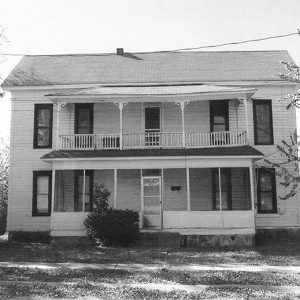calsfoundation@cals.org
Latimore Tourist Home
Located in Russellville (Pope County), the Latimore Tourist Home served African Americans from the 1940s until the 1970s as the only overnight accommodations available to them between Little Rock (Pulaski County) and Fort Smith (Sebastian County). Likely constructed around 1900, the house was added to the National Register of Historic Places on January 27, 2012.
First appearing on fire insurance maps in 1913, the home began accommodating African-American travelers sometime before 1944. Operated by Eugene Latimore and Cora Wilson Latimore and their daughter Anna, the home offered short-term accommodations for African Americans, many of whom worked on the railroad. Eugene Latimore also worked as a veterinarian. The home appeared in the 1949 Negro Motorist Green Book (usually called simply the Green Book), a publication aimed at African Americans traveling in the United States and other countries in the Western Hemisphere. This publication allowed travelers to find services in unfamiliar locations and avoid any that discriminated against African Americans. The house operated as a tourist home even after the passage of the Civil Rights Act of 1964, ceasing operations between 1970 and 1976.
The two-story home includes a one-story addition at the rear. Resting on a continuous foundation of fieldstone with some concrete block pillars located at the rear of the home, it is topped with a hipped roof and asphalt shingles. The exterior of the home is covered in the original wooden siding. Facing east, the house is fronted by a two-story porch. Accessed by a set of concrete steps, the lower porch includes a solid wooden railing and an aluminum door. The second-story porch is supported by plain wooden posts. The railing on the second story includes turned spindles and four ornamented posts with gingerbread details at the top. A hipped roof covers the second-story porch.
Entrance to the first floor is gained through centrally located wooden doors on both the first- and second-story porches. Four one-over-one double-hung windows are located on the first floor, with two on either side of the door. The second floor is much the same, with the window (a six-over-six pane) located on the north side of the home.
The south side of the home includes three wood-frame one-over-one windows with one located on each floor. The home includes a pent roof located at the bottom of the gable. The north side is similar, but the second-floor window is a one-over-six.
A single-story ell with a gable roof is located at the rear of the home on the south side. It includes an eight-pane wood-frame window and is topped with a metal awning. Located to the north, the single-story addition at the rear of the home was likely added after 1946, according to fire insurance maps. Topped with a shed roof, a row of windows located at the rear of the home are covered with a large awning. A door is located at the northwest corner of the rear of the home and is covered with a shed roof.
The structure remains a good example of a business serving African-American travelers during segregation. After ceasing operations as a boarding house, the home was used as a private residence. In 2012, a nearby church purchased the building, but plans to preserve the building stalled. The building was in disrepair and was listed on Preserve Arkansas’s 2018 List of Most Endangered Properties in the state. A non-profit organization, Friends of the Latimore Tourist Home, was established to restore and revitalize the property and, in 2022, announced plans to move the home down the street to a new location and to restore the property. The structure was moved to a temporary location on October 5, 2022.
For additional information:
“Arkansas’s Most Endangered Places, 2018.” Preserve Arkansas. https://preservearkansas.org/wp-content/uploads/2016/05/MEP-Press-Packet-2018-compressed.pdf (accessed February 10, 2020).
Bowden, Bill. “Green Book Home to Be Moved in City.” Arkansas Democrat-Gazette, June 26, 2022, pp. 1B, 5B. Online at https://www.arkansasonline.com/news/2022/jun/26/russellvilles-historic-latimore-tourist-home-to/ (accessed June 27, 2022).
———. “Latimore Building Falls into Disrepair.” Arkansas Democrat-Gazette, August 9, 2020, pp. 1B, 6B. Online at https://www.nwaonline.com/news/2020/aug/09/latimore-building-falls-into-disrepair/ (accessed June 23, 2022).
———. “Russellville’s Green Book House Moved.” Arkansas Democrat-Gazette, October 6, 2022, pp. 1B, 2B. Online at https://www.arkansasonline.com/news/2022/oct/06/historic-russellville-green-book-house-moved-to/ (accessed October 11, 2022).
Friends of the Latimore Tourist Home. https://www.latimoretouristhome.org/ (accessed June 24, 2022).
“Latimore House.” National Register of Historic Places registration form. On file at Arkansas Historic Preservation Program, Little Rock, Arkansas. Online at https://www.arkansasheritage.com/arkansas-historic-preservation-program (accessed January 3, 2025).
Schnedler, Jack. “Safe Passage.” Arkansas Democrat-Gazette, January 27, 2019, pp. 1E, 6E. Online at https://www.arkansasonline.com/news/2019/jan/27/safe-passage-20190127/ (accessed June 23, 2022).
David Sesser
Henderson State University
 Early Twentieth Century, 1901 through 1940
Early Twentieth Century, 1901 through 1940 Historic Preservation
Historic Preservation Latimore Tourist Home
Latimore Tourist Home 



Comments
No comments on this entry yet.